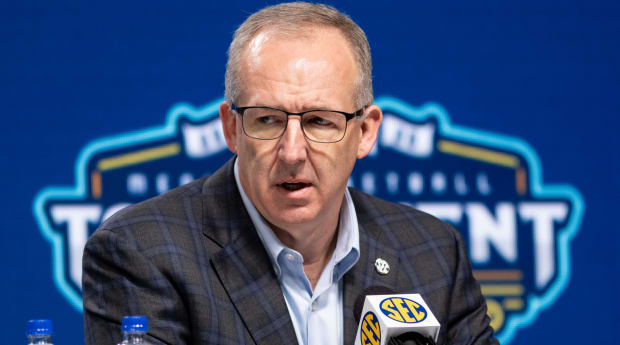LAS VEGAS—Coaches who are expecting their on-field staffs to swell in size this fall are in for a surprise.
The NCAA Transformation Committee’s concept to remove the policy limiting the number of coaches on a football staff will not be finalized by August, SEC commissioner Greg Sankey and Ohio director of athletics Julie Cromer, co-chairs of the committee, told Sports Illustrated on Tuesday.
“We have issues that have lingered for decades,” Sankey says. “It would be unwise to just flip a switch on some issues in August when you’re going into a competitive season.”
The Transformation Committee is in the fifth month of what is expected to be a yearlong process to overhaul NCAA policy and governance structure. It plans to lift decades-old rules around cost containment and legislating competitive equity in light of antitrust legal concerns raised from the Supreme Court’s Alston ruling last summer.
In April, committee leaders first shared concepts with athletic directors in Dallas, which included controversial moves that would eliminate number caps for coaches on a staff and scholarships offered to athletes on specific teams, allowing such limits to be determined by schools and/or conferences.

Andrew Nelles/Nashville Tennessean/USA TODAY Network
As previously reported by SI, those concepts were unfinished and were weeks (if not months) away from finalization. If the concepts are approved at all, Sankey and Cromer say they will be part of the latter half of a two-part process: the first wave of approvals coming in August and the second coming in January. After reports surfaced that the elimination of coaching and scholarship limitations would come in the first wave, coaches stirred, and some believed their staffs would immediately grow.
“I don’t think it’s a delay. It was out there publicly before we would have put it out there,” Sankey says. “When outlets report things, they are not always accurate.”
Football staffs are limited to one head coach and 10 assistants who can work with players in hands-on roles. Conceivably, lifting the restriction would open the door for an unlimited number of coaches to work with players and roam the sidelines in different roles. Cromer says the staff limitation concept is connected to the committee’s ongoing study of the year-round recruiting calendar, which is expected to be streamlined.
“The two will be done together,” Cromer says.
For the scholarship concept, officials are contemplating removing limitations on at least equivalency sports (sports with partial scholarships, like many Olympic sports). For example, the maximum number of scholarships allowed in baseball is 11.7 for a roster of 35—a figure often criticized by high-level, baseball-playing schools from rich conferences that want to spend more. Under the transformation’s concept, a school could conceivably offer 35.
The concepts have been met with some criticism, as there is growing concern they would stress programs financially and further widen the gap between high-resource schools and others, several administrators say.
“We didn’t set a date [to implement the concepts],” Sankey says. “We went out to sport communities and asked for perspective. You have to be thoughtful. We went to sports communities for feedback and the same on roster structure [in regards to scholarship limitation] and have engaged on recruiting issues.
“If the attitude is we have to solve everything right now, that doesn’t allow for effective decision-making. What goes to the board this week are pretty well-developed frameworks.”
Sankey adds that the concepts may not evolve into a rule change. “Don’t assume an outcome.”
As part of the first wave, the NCAA Board of Directors is expected to review proposals Thursday that would implement windows in the transfer portal, as well as an overhaul of the NCAA infractions process. In the new transfer portal with windows, players must enter the portal only during designated windows in order to use the one-time transfer exception and be immediately eligible at their new school. The new infractions process is expected to expedite investigations and hold coaches more accountable for violations. If the board approves the measures as expected, the concepts would be finalized in July and adopted in August.
It would be a big step in the committee’s progress toward more significant change, clearing the way for more work on coaching and scholarship limitations and positioning the committee to study its biggest issue—determining new criteria for Division I membership.
Division I has swelled in size to a disparate group of 350 schools that vary greatly along financial and cultural lines, a growing frustration for top FBS and Power 5 programs that believe they are handcuffed by low-resource schools. The committee is expected to seriously explore strengthening the requirement on members, much of it determined by a school’s support for athletes, such as scholarships and medical care. Among the current D-I membership criteria, schools must sponsor at least 16 sports and fund at least 50% of possible scholarships in 14 sports.
There are three initial points that will inform the committee’s thinking on any new membership criteria, Sankey says: (1) moving beyond the status quo; (2) the athlete experience; and (3) the athlete voice.
“Those three criteria can be met by every current Division I member,” he says when asked whether all 350 would remain in DI. “The answer to that question is, will there be additional expectations and how will people adapt to that? One of the elements of the charge is direct support to student-athletes.”
“It doesn’t mean we automatically kick people off the island,” Sankey told hundreds of athletic administrators Tuesday during a 90-minute panel with Cromer and other Transformation Committee members at the National Association of College Directors of Athletics Convention. “This is not just about blowing something up. This is about a commitment to working through hard issues. It is going to stress people and stretch people.”
The committee’s panel was short on specifics, but included direct comments from its leaders.
“We have student-athletes clamoring for change so much that they are taking us to court,” Cromer said. “If you read the Alston decision, it is screaming at us to change. Our backs are against the wall.”







